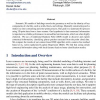Free Online Productivity Tools
i2Speak
i2Symbol
i2OCR
iTex2Img
iWeb2Print
iWeb2Shot
i2Type
iPdf2Split
iPdf2Merge
i2Bopomofo
i2Arabic
i2Style
i2Image
i2PDF
iLatex2Rtf
Sci2ools
112
Voted
BMVC
2010
2010
Using Context to Create Semantic 3D Models of Indoor Environments
Semantic 3D models of buildings encode the geometry as well as the identity of key components of a facility, such as walls, floors, and ceilings. Manually constructing such a model is a time-consuming and error-prone process. Our goal is to automate this process using 3D point data from a laser scanner. Our hypothesis is that contextual information is important to reliable performance in unmodified environments, which are often highly cluttered. We use a Conditional Random Field (CRF) model to discover and exploit contextual information, classifying planar patches extracted from the point cloud data. We compare the results of our context-based CRF algorithm with a context-free method based on L2 norm regularized Logistic Regression (RLR). We find that using certain contextual information along with local features leads to better classification results.
BMVC 2010 | Computer Vision | Context-based Crf Algorithm | Contextual Information | Semantic 3D Models |
Related Content
| Added | 10 Feb 2011 |
| Updated | 10 Feb 2011 |
| Type | Journal |
| Year | 2010 |
| Where | BMVC |
| Authors | Xuehan Xiong, Daniel Huber |
Comments (0)

